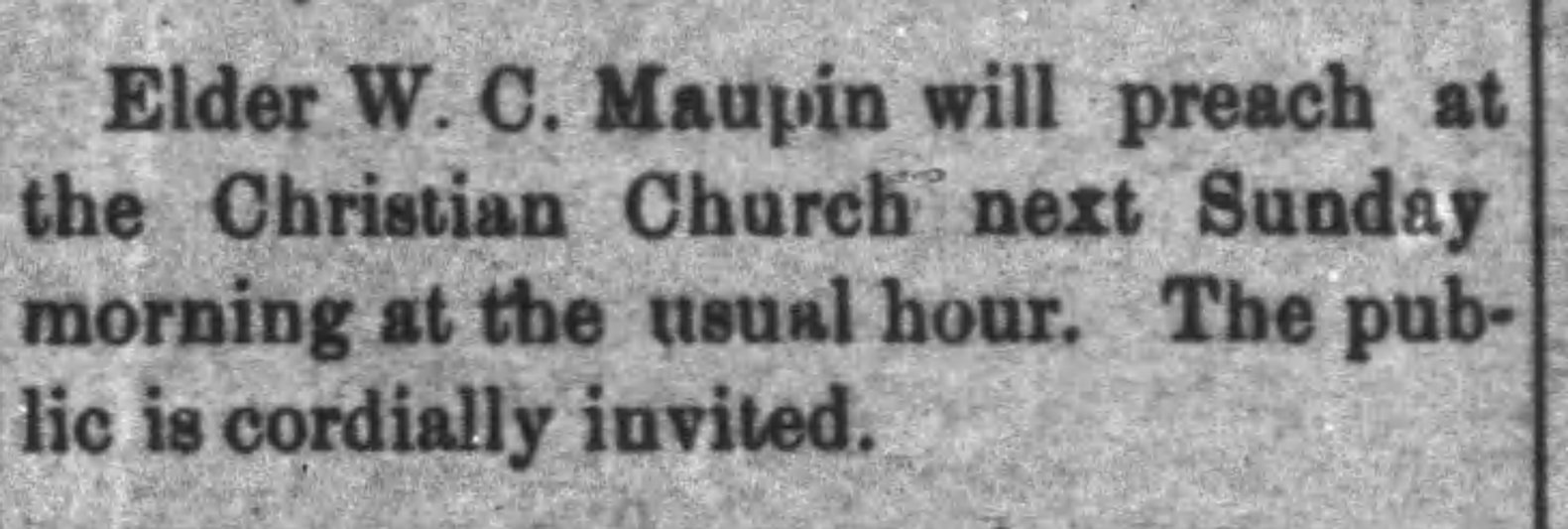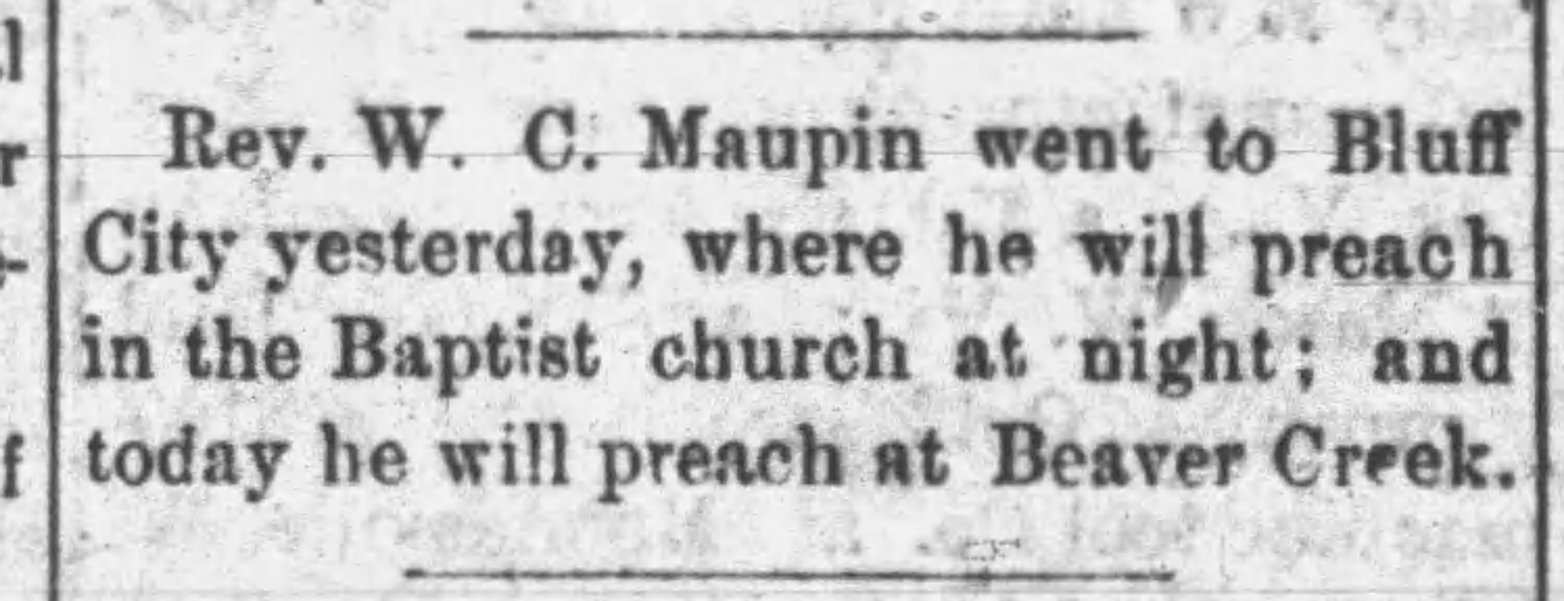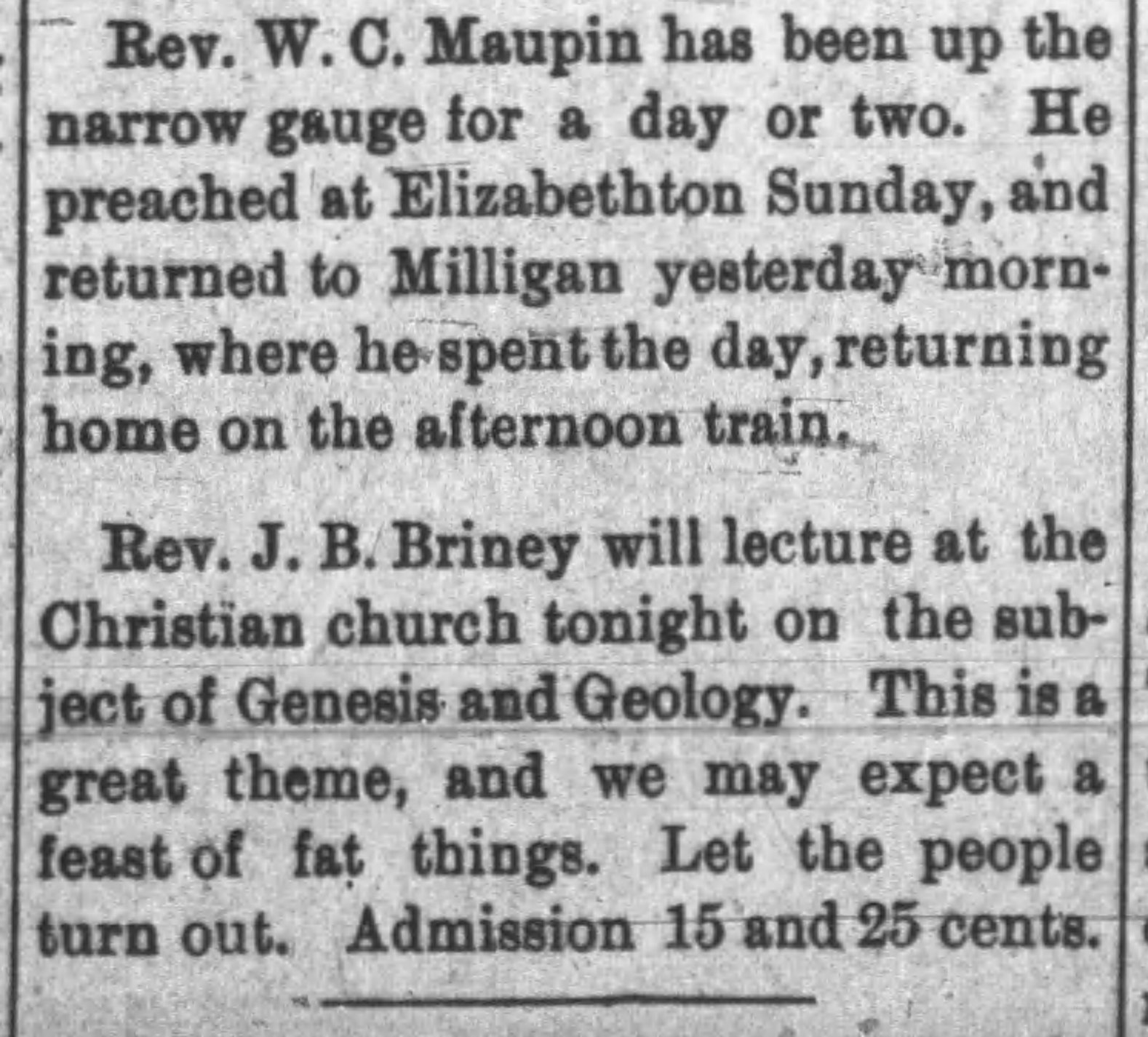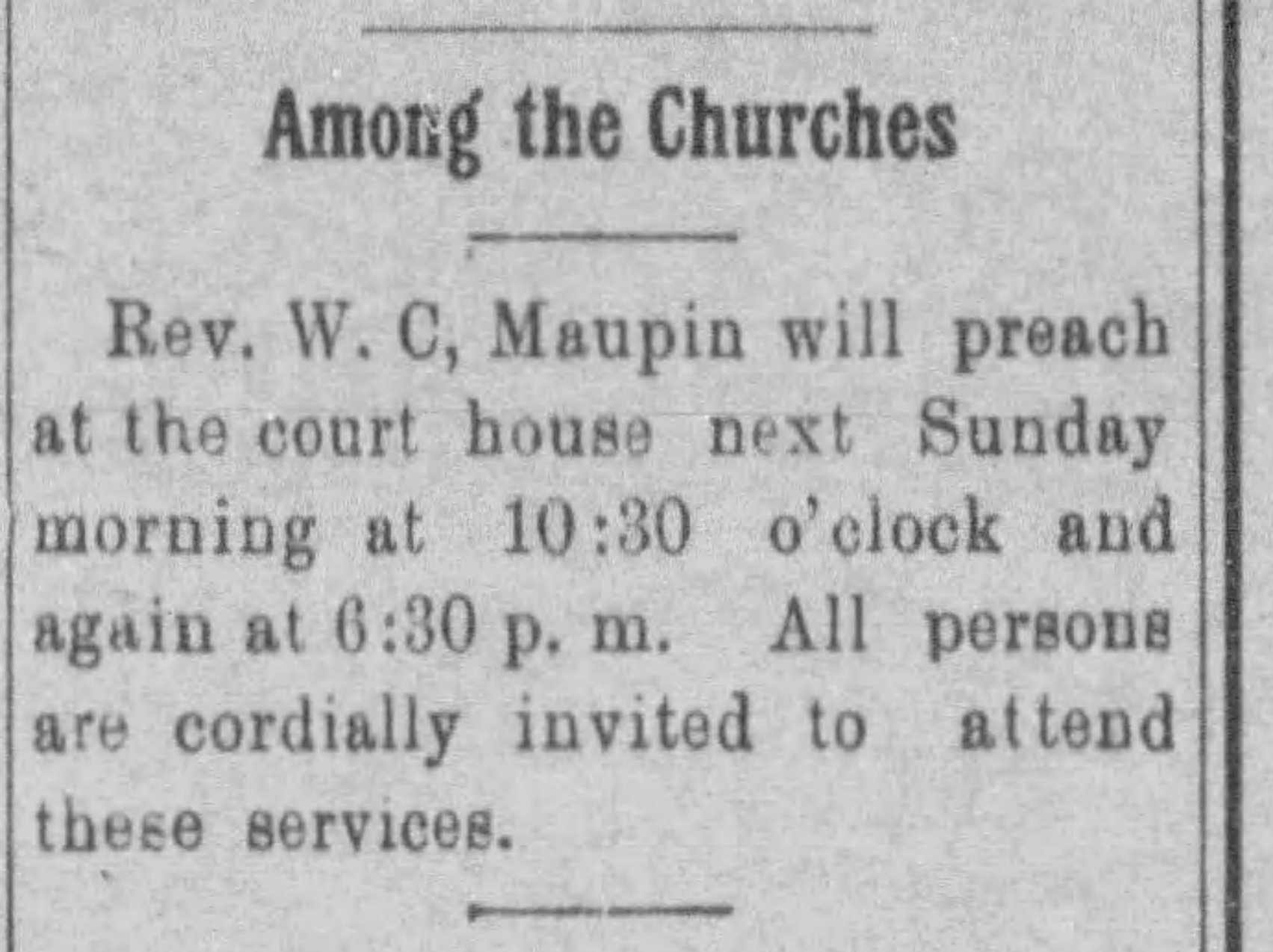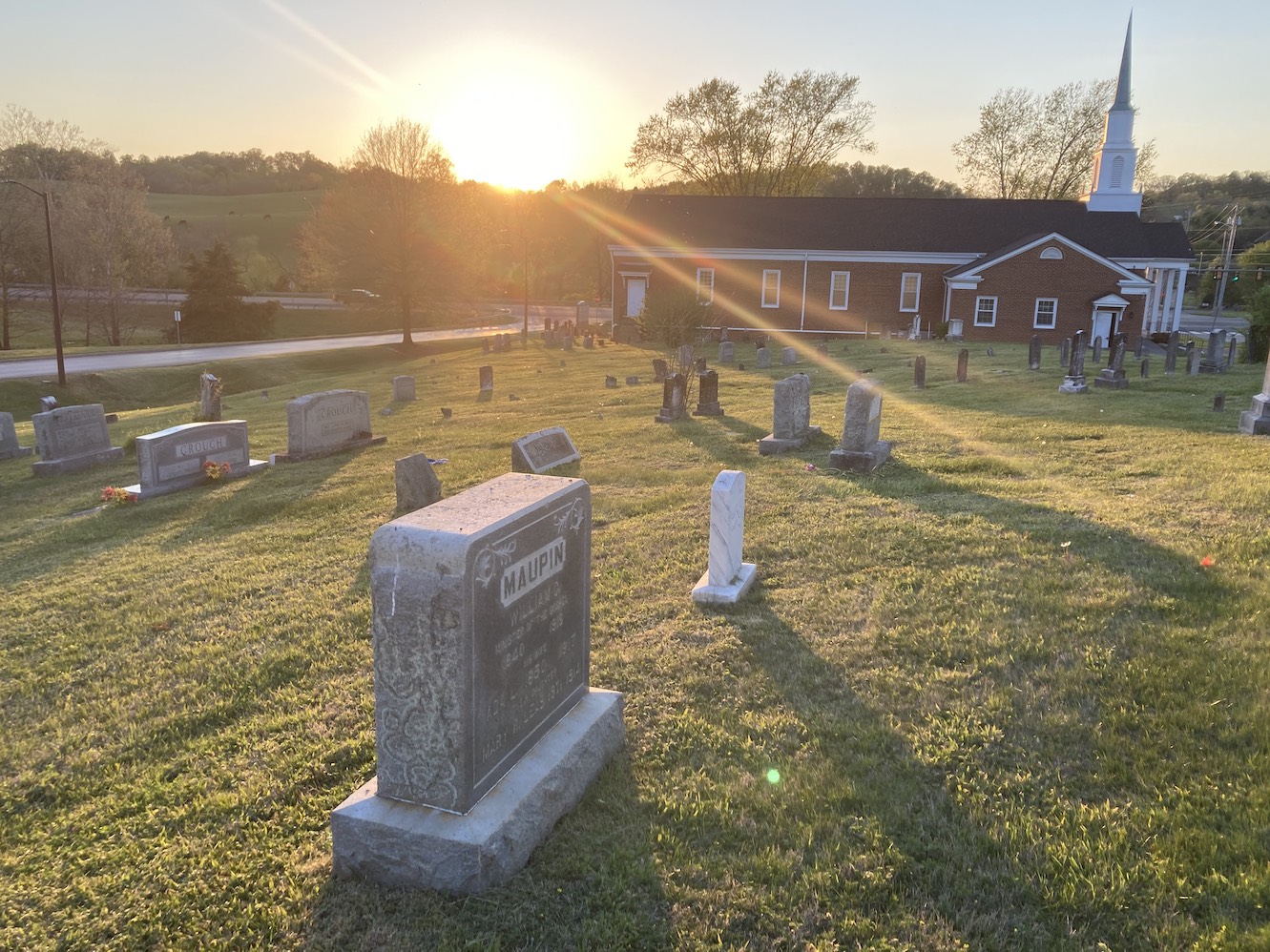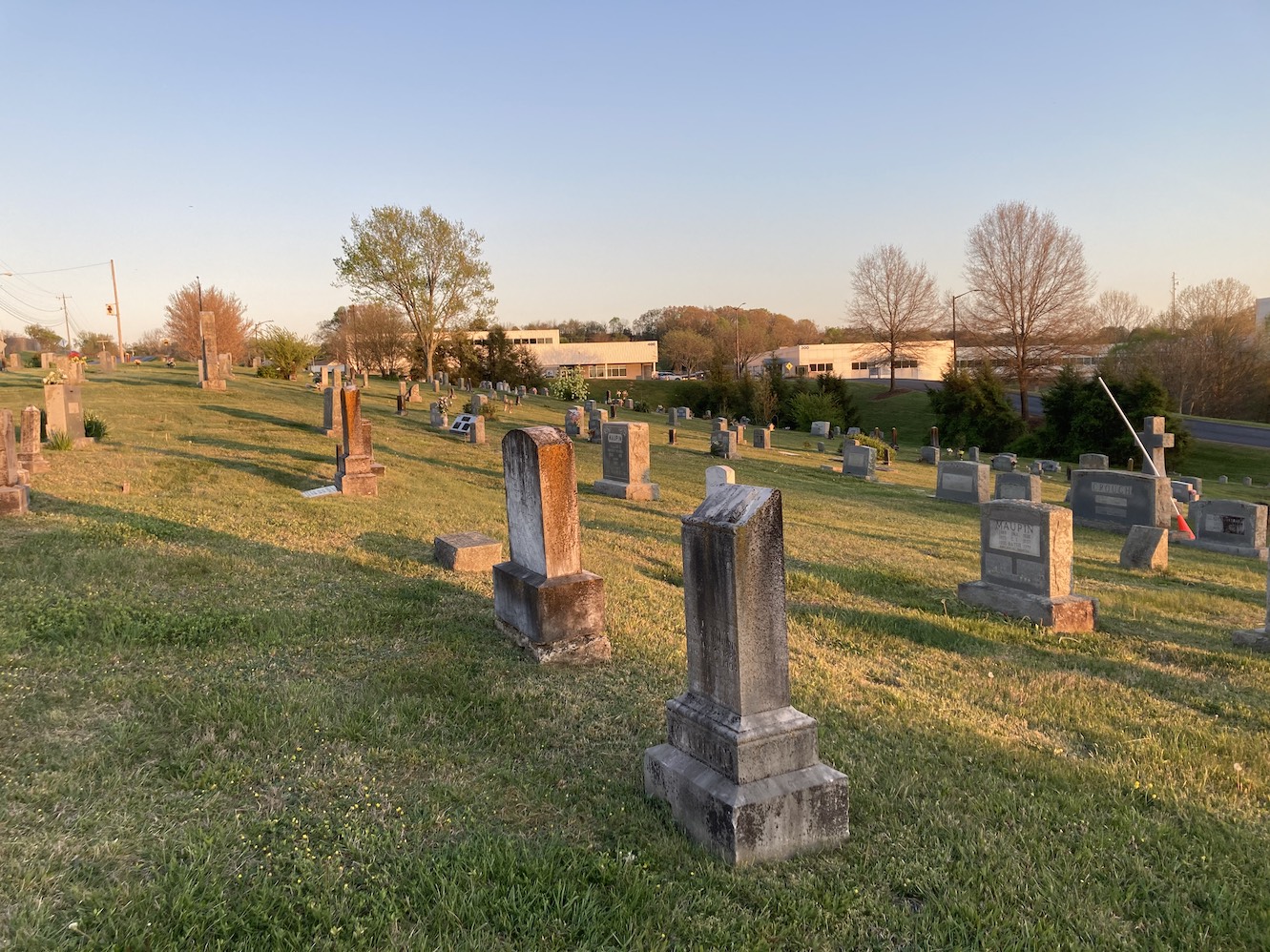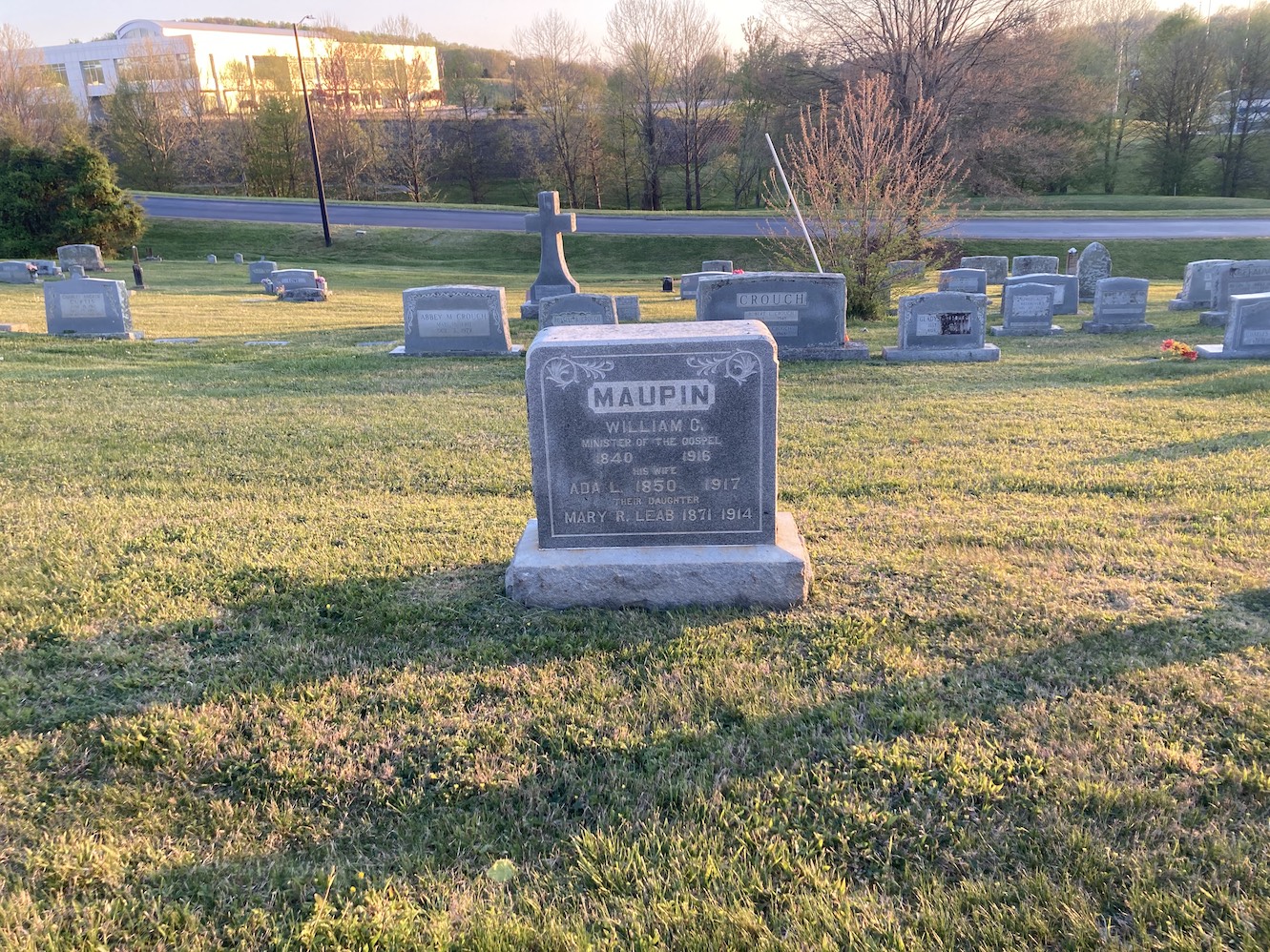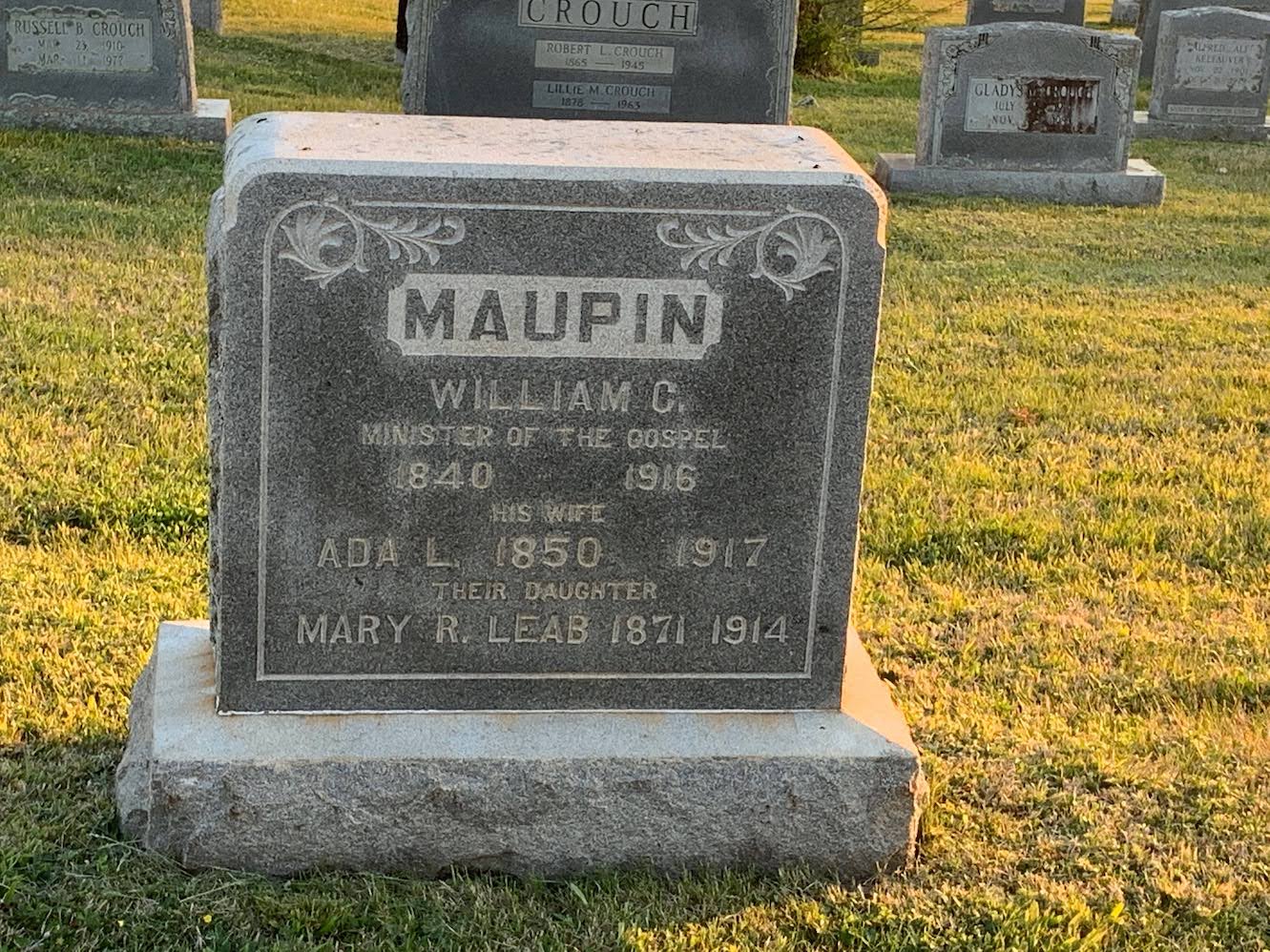William Conrad Maupin
1840-1916
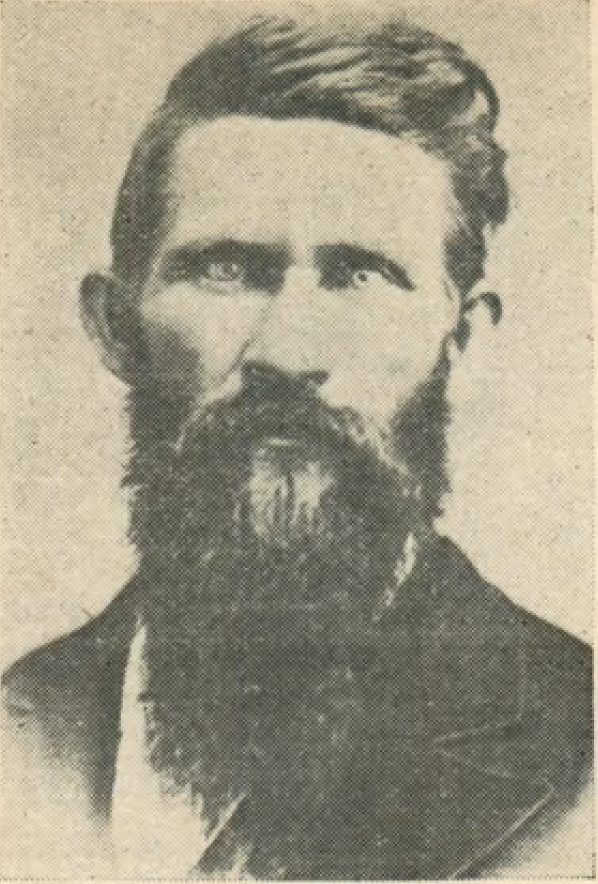
![]()
William Conrad Maupin
June 8, 1840 - June 30, 1916
In his book, "Churches of Christ," by John T. Brown, published in 1904, there is on page 618 a likeness of the subject of this sketch, and a brief accompanying word as follows: "William Conrad Maupin, Johnson City, Tenn. Born near Charlottesville, Virginia, June 8, 1840. Student of Boone's Creek Institute, East Tennessee. Failed to graduate on account of the Rebellion. United with the Church of Christ 1859. Ordained to ministry Aug. 11, 1867; preached over much of Tennessee, Southwest Virginia, Western North Carolina, Kentucky, and Northern Missouri. Minister at Johnson City five years, while church was being built. Now preaching for Boone's Creek church."
Boone's Creek was the home congregation of his parents, Willis Maupin and Rebecca Hilbert Maupin, and the church that led him to make the "good confession," obedience to Christ, and by ordination sent him forth to preach the Word.
Along about 1900 A. D., the writer remembers seeing a stereoscopic picture of W. C. Maupin, showing him standing erect in characteristic pulpit pose, an open Bible in his hand, and on the reverse printed a short summary of his life, and a few pertinent quotations such as follows, and I give them from memory: "He says concerning the world's moral progress that he 'believes that the good are getting better and the bad worse.' Again: 'I believe that the next war in this country will be between labor and capital.' "
The physical appearance of a man means something, and as I think of him today, I see him dressed, usually, in a Prince Albert, and nearly always wearing a top hat. These were more often than not, well-worn. Grayish blue eagle eyes, deeply set, a full brown beard, like Longstreet's or Longfellow's, but longer, a grand frame had he, tall and slender of build, his heighth accentuated both by his long coat and tall hat. He often wore one particular hat with a deal of pride, a "beaver," because it had been presented to him by his fellow townsman, neighbor and friend, Gov. Robert Love ("Bob") Taylor.
William C. Maupin was inseparably identified with the Cause of New Testament Christianity throughout all this country in a large way. He had to do, in many instances, with beginnings. He did not seek places of ease, but places of service. While a lad, I heard him entreat my own home congregation, where he ministered at the time, and where he received the handsome sum of five dollars for his monthly visits, to bring their payments up to date, because, as he said, "My son Arthur has just married and is bringing his bride home, and we want to put the big pot into the little one." This was at Hale's Chapel, Washington County, Tennessee.
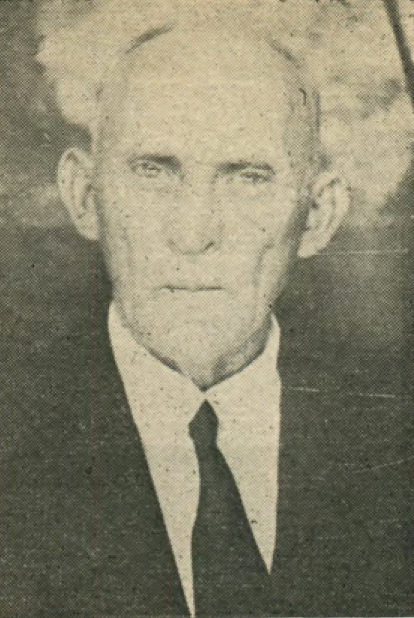
Arthur C. Maupin
son of W. C. Maupin
Take for instance our Cause in Johnson City. His was the spirit back of a movement to establish a congregation there. He became the first pastor of our First Church where he ministered five years. As Peter, James and John were fishermen, Luke a physician and Paul a tent-maker, W. C. Maupin was a cabinet maker, and the first pulpit at First Church was a product of his own hands, a pulpit still in use by one of our other churches in the city.
Referring to this period, Dr. Josephus Hopwood, in his "A Journey Through The Years," tells of searching out a site for a Christian school, and on his way to Buffalo Institute, now Milligan College, says: "In August, 1875, I reached Johnson City, then a town of fifteen hundred people, and was kindly entertained over night in the home of W. C. Maupin. Next day being Sunday, we heard him preach in the schoolhouse on Science Hill, the disciples having no house of worship and few members."
On February 20 of this same year, J. C. Hardin and H. H. Crouch were appointed trustees of First Christian Church, E. Meadows, J. C. Hardin and W. C. Maupin were made elders, the last named being minister, his name also added to the Building Committee.
Col. E. C. Reeves carries us back across the years in beautiful reminiscence, given at a notable celebration when he says: "The Rev. W. C. Maupin, a school-mate of mine was a direct product of the old Brick Church, by the grace of God. At school upright and pleasant, 'when the fur was rubbed the right way,' he attended strictly to his own business and he fully expected others to do the same as to matters affecting him. When challenged to controversy, public or private, he could never find the word 'decline' in his lexicon. 'Billy' was a good student, an upright citizen, a strong preacher, a good man. He was my long time friend, and his passing made me sad."
Only the Recording Angel can give a true portrayal of the life and labors of W. C. Maupin. Hundreds were converted and baptized by him, and that in a day when every foot of ground won for the Apostolic order was contested by sectarianism. Many churches owe both their being and their well being to this pioneer. Scores of debates were held. It was "Bill" Maupin then, "Bill" Maupin with the two-edged sword. Many struggling congregations looked instinctively to him in that day, amid their persecutions and struggles: Everywhere he was referred to affectionately as "the old war horse."
More than once were school houses and other buildings locked against him. At one place a great crowd gathered for an evening worship and sermon. The school house was locked, the door barred. Some wanted to break in anyway, but W. C. Maupin knew a better way. He invited the audience to a nearby grove, to God's open temple. He did not preach the sermon he had planned, but changed his subject. The friends of the Lord gathered there under the stars that night were almost motionless when from Matt. 8:20 the tall, strong preacher read: "The foxes have holes, and the birds of the air have nests; but the Son of man hath not where to lay his head." Can anyone doubt the far-reaching effects of a sermon from a text like that, and given under such circumstances.
I do not know how many young men were inspired by the example and words of this great minister to take up their cross in the Christian ministry. I give one example, that of John N. Shepherd of Milligan College. He and I parted at the door-way of the Preacher Maupin residence at Johnson City, Tenn., to prepare for the proclamation of the Gospel of Jesus Christ, he to enter Milligan College, I to enter Kentucky University. For years, Brother Shepherd, this his "son in the Gospel," evangelized in the First District of Tennessee, and still ministers to our churches here, a worthy, powerful man of God.
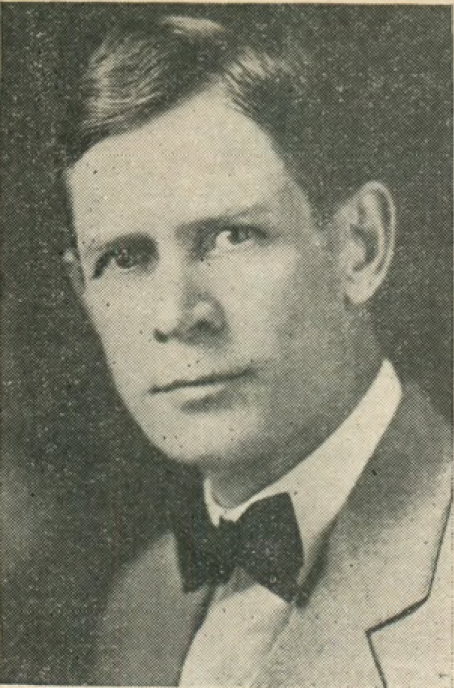
A. Preston Gray
(writer of this piece)
Uncle Will was plain spoken, but gentle, possessing a wonderful sense of humor. Endowed with "mother wit," he was quick at repartee. Once he preached a sermon, illustrating a point by telling how many farmers permitted briars and thorns to grow up in the fence corners of their farms. After the sermon a brother came up, feeling hurt that the preacher should single him out, "for everybody," said he, "knew you were hitting at me." "No,no, my brother, I did not even remotely refer to you. I was telling how men permit their fence-rows and hedges to grow up in weeds, and made no reference to the man who permits his whole farm to grow up with briars."
But a brilliant man sometime in life, gets the tables turned on him. At Hale's Chapel there was a unique character who actually lived, it seemed, just to argue. No one knew his Bible better. I refer to "Kane" (Elkanah) Martin. One day he tried to tie up my uncle in an argument. Out of patience, Uncle Will said: "Kaney, you are the father of all fools," and quick as a flash, Mr. Martin said: "Well then, why don't you call me daddy."
In August, 1911, at Mount Olivet, near Greeneville, Tenn., W. C. Maupin met in debate Dr. W. B. Godby, a Methodist preacher. But before the discussion was over, Dr. Godby had fled the field, leaving it to his opponent. A copy of that debate is before me as I write.
Dr. B. A. Abbott wrote me at Fort Worth, Texas, while I was pastor of University Church at T. C. U., there, and he was editor of "The Christian Evangelist," "Brother Gray, I always loved you, but I would never have loved you as I do now since knowing that you are the nephew of W. C. Maupin. His was the brightest mind I ever knew."
W. C. Maupin disliked sham, despised in sincerity, was merciless against hypocrisy. He hated war. He said that it was of the devil. Conscripted into the Confederate Army during the Civil War, he refused to fight. They gave him a gun, but he told them that they could not make him shoot it. They issued him ammunition, but he refused to use it. In battle, he set the butt of his gun on the ground at his feet, and started reading the New Testament his mother had given him when he started away, bullets on their pitiless mission of destruction whizzing by. For his insubordination he was court-martialed. He was to face the firing squad. But in the nick of time pardon came from Gen. J. C. Breckinridge and a life spared for a greater warfare. I have seen the yellow pages of the old newspaper containing the account of that hair raising and touching experience.
During the illness that took him from us, I visited him in a Johnson City hospital. It was sad to see this worn, tired servant of Christ go under the surgeon's knife. On my way out, I met my mother, and the mother of another nephew preacher of Uncle Will, John P. Ellis, sisters, nearing the hospital with heavy hearts, tears and flowers. But his strength and age could not stand the shock. June 30, 1916, he departed to be with the Father. His remains appropriately rest in the little cemetery of the old brick church at Boone's Creek, his ashes mingling with the dust of his fathers, his kin, neighbors and friends-those who knew him best and loved him most.
The following is quoted from A Journey Through the Years, by Josephus Hopwood:
"Come to Boone's Creek tomorrow at twelve o'clock. Brother Maupin is dead. The burial will be at that hour."
I went on the day appointed.
How rapidly the past came to mind!
One Saturday evening in August, 1875, I reached Johnson City, and had my first night's rest in Brother Maupin's home. Next morning—Lord 's Day—he preached in the upper story of the old Science Hill Academy. The audience was small, but his logical thought and his forceful, sincere manner showed plainly we had come to a clear-headed honest man. He was later one of the pioneers in establishing that great First Church in Johnson City.
He loved the truth and had the courage to speak his convictions. He was a warrior for the right, yet had a good word for all.
Neither did anyone doubt the sincerity of his motives. He lived in the open.
I loved him for what he was, for what he did and for what his possibilities were. When the shackles of time and environment were broken a great spirit was released for a nobler, fuller service. We shall meet him in that new and perfect Life.
A Preston Gray, in J. W. West, Sketches of Our Mountain Preachers, pgs. 50-58
![]()
The Comet, Johnson City, Tennessee
Wednesday, January 27, 1892, p.1
![]()
The Comet, Johnson City, Tennessee
Sunday, May 1,1892, p.1
![]()
The Comet, Johnson City, Tennessee
Tuesday, May 17,1892, p.4
Note: J. B. Briney was a well know Christian church preacher from Kentucky
![]()
Morristown Republican, Morristown, Tennessee
Friday, February 15, 1907, page 1
![]()
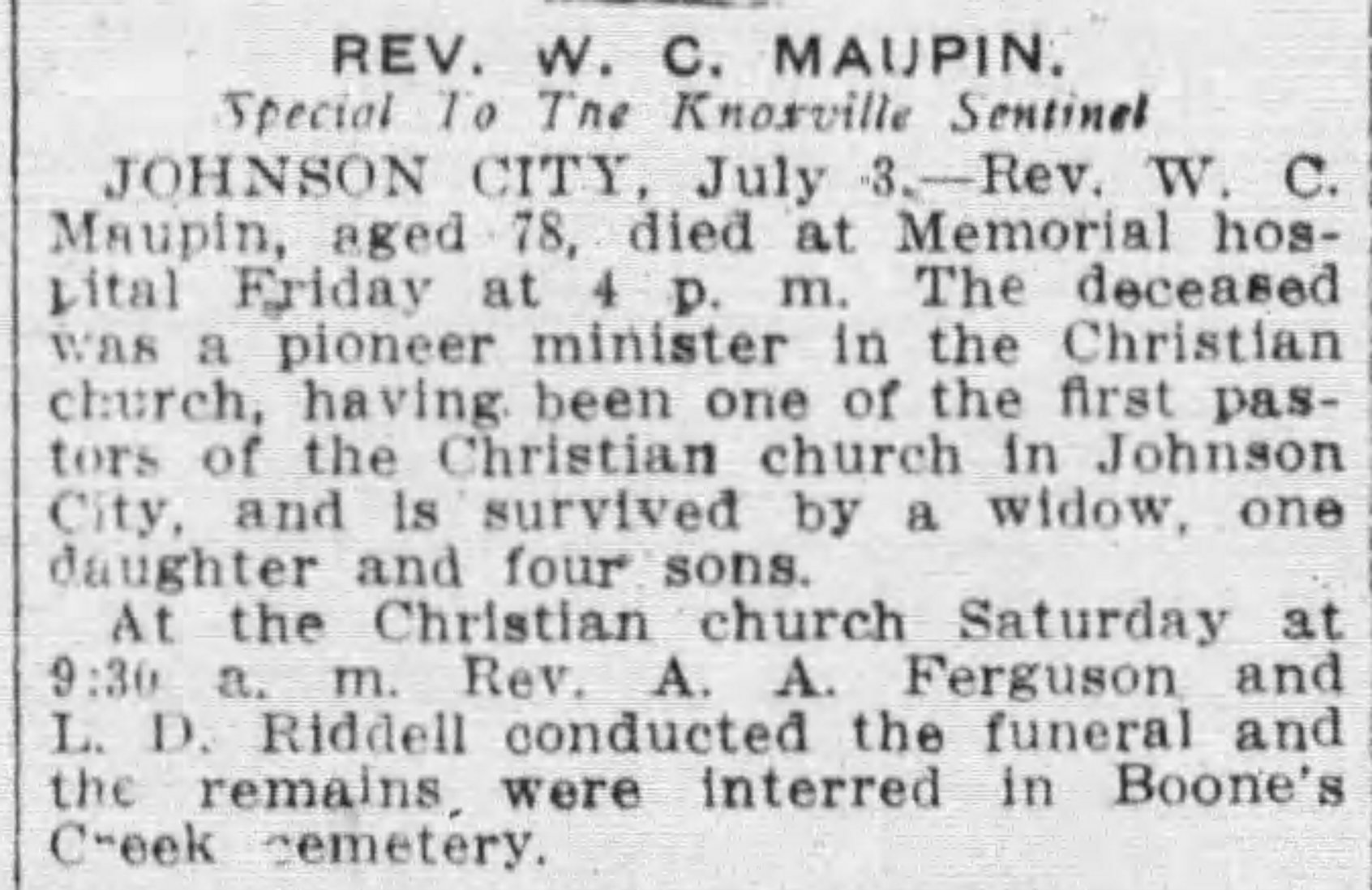
Knoxville Sentinel, Knoxville, Tennessee
Monday, July 3, 1916, page 12
![]()
Directions To Grave
W. C. Maupin is buried in the Boone's Creek Christian Church Cemetery behind the church. It is located just north of Johnson City, Tennessee, just of I-26 (James H. Quillen Parkway.) Take Hwy. 354, Exit 17, and head west (right from the north, left from Johnson City) on Boones Creek Rd. The Boones Creek Christian church is only a block or two on the left. Take that first road, Christian Church Rd. up behind the building to the cemetery. The Maupin plot is about center of the cemetery. The GPS below is actual location of the grave.
GPS Location
36°22'17.0"N 82°25'39.9"W
or D.d. 36.371387,-82.427750
![]()
MAUPIN
William C.
Minister Of The Gospel
1840-1916
His Wife
Alda L 1850-1917
Their Daughter
Mary R. Leab 1871-1914
![]()
Photos Taken 04.19.2021
Webpage produced 12.27.2022
Courtesy Of Scott Harp
www.TheRestorationMovement.com
Special Recognition: C. Wayne Kilpatrick and Tom L. Childers in traveling with me in April, 2021 over to the very eastern part of Tennessee to find graves of restoration preachers.
![]()
